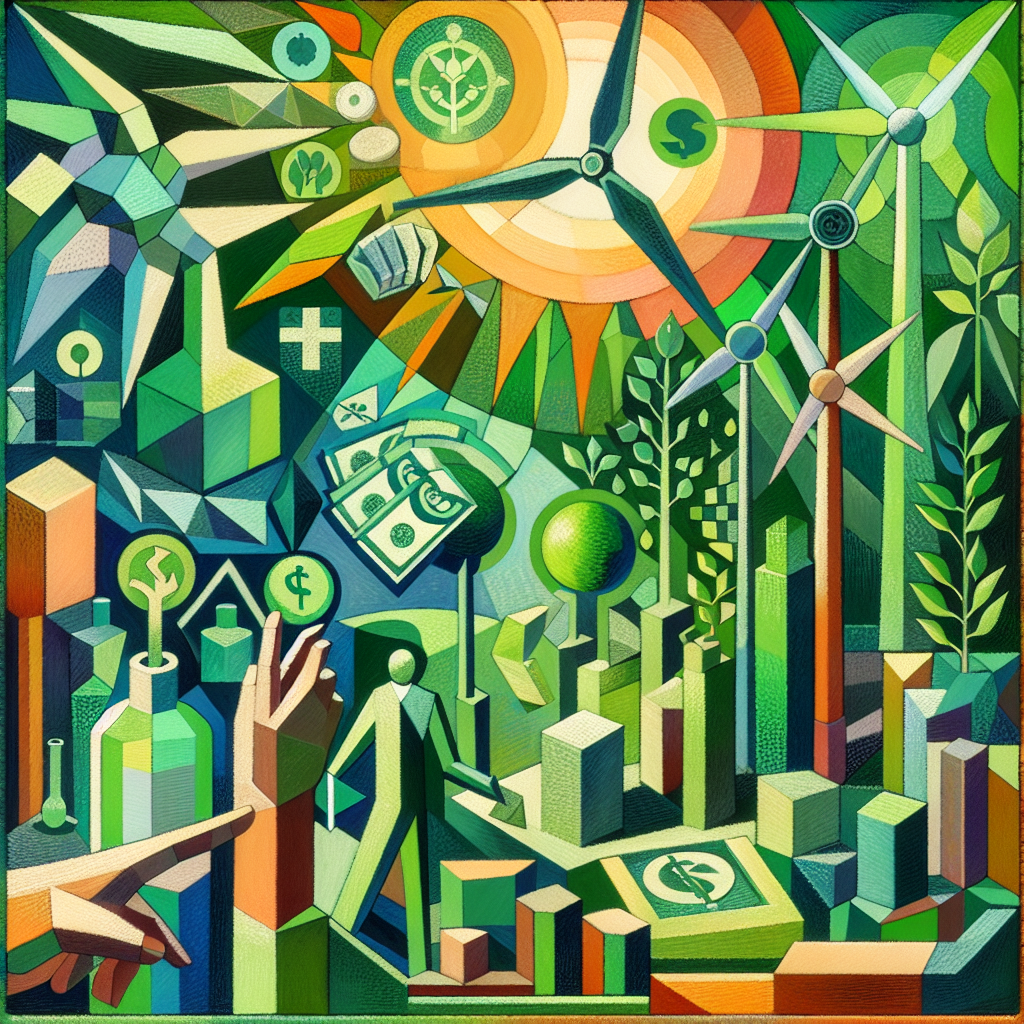Green Loan

Financing a Sustainable Future
Green loans are financial instruments specifically designed to support environmentally sustainable projects. These loans provide the necessary capital for initiatives that have a positive impact on the environment, such as renewable energy projects, energy efficiency improvements, pollution prevention, sustainable agriculture, and conservation efforts. Green loans are typically offered with favorable terms, such as lower interest rates or longer repayment periods, to incentivize borrowers to invest in green projects. They are an essential part of the broader sustainable finance movement, which aims to align financial services with long-term environmental sustainability and the transition to a low-carbon, climate-resilient economy.
Ready to make a positive impact on the environment and finance your eco-friendly projects? Apply for a Green Loan today! Visit personalloansonlineinstantapproval.com to get started on your journey towards sustainability with instant approval on personal loans. Act now for a greener tomorrow!
Understanding Green Loans: Benefits and Eligibility Criteria
Green loans have emerged as a pivotal financial instrument in the global effort to support environmentally sustainable projects. These loans are specifically designed to encourage the development of eco-friendly initiatives, ranging from renewable energy production to the construction of energy-efficient buildings. As the world grapples with the urgent need to address climate change, green loans offer a pathway for businesses and individuals to contribute to a more sustainable future while also potentially benefiting from financial incentives.
The concept of a Green Loan is rooted in the principle of positive environmental impact. Unlike conventional loans, green loans are granted on the condition that the funds are used for projects that have clear environmental benefits. This could include investments in solar panels, wind turbines, or the retrofitting of buildings to improve energy efficiency. The overarching goal is to reduce carbon footprints, conserve natural resources, and promote the transition to a low-carbon economy.
One of the primary benefits of green loans is their potential to make sustainable projects more financially viable. By offering more favorable terms such as lower interest rates or longer repayment periods, green loans can help to offset the initial costs associated with green technologies, which are often higher than their traditional counterparts. This financial support can be crucial in tipping the scales for decision-makers who are weighing the long-term environmental benefits against short-term financial considerations.
Moreover, green loans can serve as a testament to a company’s commitment to sustainability, enhancing its reputation among consumers and investors who are increasingly conscious of environmental issues. This reputational boost can translate into competitive advantages, as a growing segment of the market favors businesses that demonstrate corporate social responsibility.
Eligibility criteria for green loans can vary depending on the lender and the specific Green Loan program. Generally, to qualify for a Green Loan, applicants must demonstrate that the funds will be used for an eligible green project. This typically involves providing a detailed plan of the project, including its expected environmental benefits and how these will be measured and reported. Lenders may require third-party certification or verification to ensure that the project aligns with recognized environmental standards or guidelines.
Applicants for green loans may also need to meet certain financial criteria, such as creditworthiness and the ability to repay the loan. However, the specific financial requirements will depend on the lender and the size and scope of the project. Some Green Loan programs are designed to be more accessible, offering support to smaller businesses or individual consumers who may not have the same financial resources as larger corporations.
In addition to businesses, governments and non-profit organizations may also be eligible for green loans, particularly if they are involved in community-based environmental projects or initiatives that have a broader public benefit. This inclusivity ensures that a diverse range of actors can participate in and contribute to the green economy.
In conclusion, green loans represent a significant step forward in aligning financial mechanisms with environmental objectives. By providing the necessary capital to fund sustainable projects, these loans can help bridge the gap between economic development and environmental conservation. As the eligibility criteria for green loans continue to evolve, it is essential for potential applicants to stay informed about the opportunities available to them. With the right support, green loans can empower a wide array of stakeholders to make a positive impact on the planet while also reaping the financial and reputational rewards of their green investments.
How to Apply for a Green Loan: A Step-by-Step Guide

Green loans have emerged as a pivotal financial tool in the global effort to support environmentally sustainable projects. These loans are specifically designed to fund initiatives that have a positive impact on the environment, such as renewable energy installations, energy efficiency upgrades, and sustainable resource management. As the world becomes increasingly aware of the importance of environmental stewardship, the demand for green loans is on the rise. For individuals and businesses looking to contribute to a greener future, understanding how to apply for a Green Loan is essential. This step-by-step guide will walk you through the process, ensuring that you are well-equipped to secure funding for your eco-friendly project.
The first step in applying for a Green Loan is to conduct thorough research on potential lenders. Traditional banks, credit unions, and specialized green financing institutions may offer green loans, each with their own set of criteria and benefits. It is crucial to compare the terms, interest rates, and eligibility requirements of various lenders to find the best fit for your project. Additionally, some lenders may offer incentives or lower rates for projects that meet certain environmental standards, so it is important to be aware of these opportunities.
Once you have identified potential lenders, the next step is to prepare a detailed project proposal. This document should clearly outline the environmental benefits of your project, such as reduced carbon emissions or improved energy efficiency. Be sure to include specific data and projections to support your claims. A well-prepared proposal not only demonstrates the environmental impact of your project but also shows lenders that you have a solid plan in place and are committed to its success.
After your proposal is ready, you will need to gather all necessary documentation. This typically includes financial statements, proof of income, and any relevant environmental certifications or assessments. Having these documents organized and readily available will streamline the application process and demonstrate your credibility to potential lenders.
The fourth step is to complete the loan application. This process may vary depending on the lender, but it generally involves providing personal and financial information, as well as details about your project. Be meticulous when filling out the application to avoid any errors that could delay the approval process. If you have any questions or concerns, do not hesitate to reach out to the lender for clarification.
Once your application is submitted, the lender will review your proposal and documentation. This review process can take several weeks, during which the lender may request additional information or clarification. It is important to respond promptly to any inquiries to keep the process moving forward.
If your application is approved, the final step is to review and accept the loan terms. Carefully read through the loan agreement to ensure that you understand all the conditions, including the repayment schedule and any covenants related to the environmental impact of your project. Once you are satisfied with the terms, you can sign the agreement and receive the funds to begin your green initiative.
In conclusion, applying for a Green Loan requires careful preparation and attention to detail. By researching lenders, crafting a compelling project proposal, organizing your documentation, meticulously completing the application, and understanding the loan terms, you can increase your chances of securing funding for your environmentally sustainable project. With the right approach, a Green Loan can be a powerful catalyst for positive environmental change, allowing you to contribute to a healthier planet while pursuing your eco-friendly goals.
The Impact of Green Loans on Sustainable Development Initiatives
Green loans have emerged as a pivotal financial instrument in the quest to support sustainable development initiatives. These loans are specifically designed to fund projects that have a positive impact on the environment, ranging from renewable energy production to the construction of energy-efficient buildings. The proliferation of green loans is a testament to the growing recognition that financial markets can play a crucial role in addressing environmental challenges.
The impact of green loans on sustainable development is multifaceted. Firstly, they provide the necessary capital to jumpstart projects that might otherwise struggle to secure funding. Traditional lenders have often been hesitant to finance projects with an environmental focus due to perceived risks and uncertainties. Green loans, however, come with the understanding that such investments are not only viable but also essential for a sustainable future. This shift in perspective is crucial for mobilizing the large sums of money required to transition to a low-carbon economy.
Moreover, green loans often come with favorable terms, such as lower interest rates or longer repayment periods, which reflect the positive externalities associated with sustainable projects. These terms acknowledge the societal benefits of environmental initiatives, such as reduced greenhouse gas emissions or conservation of natural resources. By making green projects more financially attractive, green loans incentivize businesses and governments to prioritize sustainability in their operations and policy-making.
Another significant impact of green loans is the signal they send to the market. As more financial institutions offer green loans, it becomes clear that sustainability is not just a niche interest but a mainstream demand. This market signal encourages companies to develop more green projects, knowing that there is a growing pool of capital available for such endeavors. It also spurs innovation as firms seek to create projects that qualify for green financing, leading to advancements in green technologies and practices.
Green loans also play a critical role in setting standards for what constitutes a sustainable project. Many Green Loan frameworks align with internationally recognized principles, such as the Green Loan Principles (GLP), which provide guidelines on the use of proceeds, project evaluation, and reporting. These standards ensure that funds are used for genuinely sustainable projects and help to prevent “greenwashing,” where projects are misleadingly marketed as environmentally friendly.
Furthermore, the reporting requirements associated with green loans enhance transparency and accountability. Borrowers are typically required to report on the environmental impact of the financed projects, which not only allows lenders to assess the effectiveness of their investments but also provides valuable data on the real-world outcomes of sustainable development initiatives. This information can be used to refine future projects and policies, creating a feedback loop that continually improves the efficacy of sustainability efforts.
In conclusion, green loans are a powerful tool for driving sustainable development. By providing accessible financing, incentivizing green projects, signaling market demand, setting standards, and enhancing transparency, they help to integrate environmental considerations into the financial decision-making process. As the world grapples with the urgent need to address climate change and other environmental issues, green loans offer a promising pathway to align economic growth with ecological preservation. Their continued growth and evolution will be instrumental in achieving the ambitious goals set forth by the global community to ensure a sustainable future for all.
Q&A
1. What is a Green Loan?
A Green Loan is a type of loan instrument specifically designed to finance projects that have positive environmental impacts, such as renewable energy projects, energy efficiency upgrades, pollution prevention, sustainable agriculture, and conservation efforts.
2. How do Green Loans differ from traditional loans?
Green Loans are differentiated by their explicit use for environmentally friendly projects with clear environmental criteria and often come with potentially lower interest rates, favorable terms, or financial incentives. They may also require borrowers to report on the environmental impact of the financed projects, unlike traditional loans which do not have such specific use-of-proceeds criteria.
3. What are the benefits of a Green Loan for businesses?
The benefits for businesses taking out Green Loans can include reduced borrowing costs, improved corporate image and sustainability credentials, potential tax advantages, and access to a growing market of environmentally conscious investors and customers. Additionally, these loans can help businesses comply with environmental regulations and contribute to long-term operational savings through energy efficiency and reduced waste.Green loans are financial instruments designed to support environmentally sustainable projects. They provide borrowers with capital to invest in renewable energy, pollution prevention, sustainable agriculture, and other eco-friendly initiatives. The conclusion is that green loans are an effective tool to promote environmental sustainability, offering economic incentives for businesses and individuals to engage in practices that have a positive impact on the planet.



